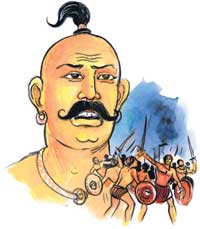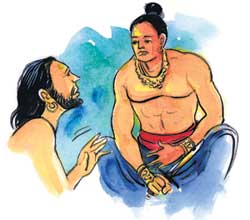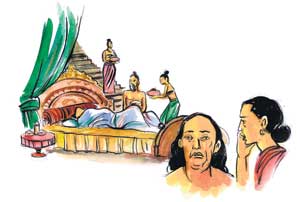
| This article is part of a continuing series on the 'Mahavamsa,' the recorded chronicle of Sri Lankan history The power struggle in Ruhuna The tactics adopted by the people of the south were successful. The Cholas who came crashing in were soon subdued. They were taken by surprise. The young Sinhala soldiers who were seething in pain were invigorated by their national feelings. They made the entire 'Palatu-pahana' area, a pool of Chola blood. The dead bodies of the Chola soldiers were scattered all over. Yet, the battle did not end there. The other Cholas who had set up camp in different locations of the south, joined together. The people of the South, celebrated their victory. The commanders who led the battle were felicitated. They were conferred honours by Prince Kashyapa. The two ministers Keerti and Buddha were entrusted with more power. The people of Malaya-rata and Maya-rata, who were thrilled over this victory, came to settle down in the south. By this time, the Sinhala population in the south had increased. They were militarily strong. This was an eyesore for the Cholas. They got down another Chola army from South India. The Sinhala King Mahinda V – who was in Balipura, under the Cholas had died by this time. The Sinhala people were feeling very sad about the death of their king. They performed various religious activities in the name of the king and conferred merit on him. As Ruhuna gained power, there were a number of provincial leaders coming up. They were fighting for power. No one wanted to be overpowered by the other person and so there was rivalry. The entire Ruhuna became a battle-field once more. The area was divided into different principalities where a leader became powerful. Among these provincial rulers were some who were very brave. Some, in fact, were clever warriors. Prince Kasub, by this time was a sick person. He was suffering from some serious ailment. Though he had enlisted a huge army to fight the Cholas, even before he could set out, the prince died. According to the 'Rajavaliya,' this happened in 1040 AD. If that were so, he had died a little before King Mihindu, his father. This prince is also referred to as Vickramabahu. South Indian history too makes this same reference. |
| || Front
Page | News
| Editorial
| Columns
| Sports
| Plus
| Financial
Times | International
| Mirror
| TV
Times | Funday
Times | |
| |
Copyright
2006 Wijeya
Newspapers Ltd.Colombo. Sri Lanka. |
 They
marched to 'Palatu-pahana' in batches and at intervals. The Sinhala
army was able to face them. They thought of fighting till the last
Chola soldier was killed. The fighting went on for six long months.
The army fought bravely. Most of the enemy was killed. The few who
managed to escape alive were frightened to stay anywhere in the
south. They fled to Polonnaruwa. Now there was a new awakening in
the south. They forgot about the devastation caused.
They
marched to 'Palatu-pahana' in batches and at intervals. The Sinhala
army was able to face them. They thought of fighting till the last
Chola soldier was killed. The fighting went on for six long months.
The army fought bravely. Most of the enemy was killed. The few who
managed to escape alive were frightened to stay anywhere in the
south. They fled to Polonnaruwa. Now there was a new awakening in
the south. They forgot about the devastation caused. In
South Indian history it says, "Mihindu V, who was taken to
the Chola country, as a prisoner was there for 12 years and passed
away." The people knew of the misdeeds of the king. But still
they loved him as he was their ruler. They were prepared to forget
and forgive. The king had passed away in 1041 AD.
In
South Indian history it says, "Mihindu V, who was taken to
the Chola country, as a prisoner was there for 12 years and passed
away." The people knew of the misdeeds of the king. But still
they loved him as he was their ruler. They were prepared to forget
and forgive. The king had passed away in 1041 AD. Though
the leaders were involved in this race for power, most of them were
good rulers too. If they were united, chasing away the enemy would
not have been a difficult task. It was the sheer misfortune of the
country to have them divided. Before long, they became erstwhile
enemies. They went into conflict wherever they met each other. This
was an advantageous situation for the Cholas. It paved the way,
for the Cholas to come back to the south. Their armies marched down,
setting fire to villages and causing damage to life and property.
Moreover, they went on a plundering spree.
Though
the leaders were involved in this race for power, most of them were
good rulers too. If they were united, chasing away the enemy would
not have been a difficult task. It was the sheer misfortune of the
country to have them divided. Before long, they became erstwhile
enemies. They went into conflict wherever they met each other. This
was an advantageous situation for the Cholas. It paved the way,
for the Cholas to come back to the south. Their armies marched down,
setting fire to villages and causing damage to life and property.
Moreover, they went on a plundering spree.